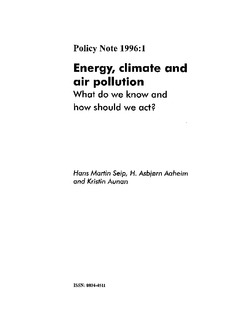| dc.contributor.author | Seip, Hans Martin | nb_NO |
| dc.contributor.author | Aaheim, H. Asbjørn | nb_NO |
| dc.contributor.author | Aunan, Kristin | nb_NO |
| dc.date.accessioned | 2014-03-17T14:28:54Z | |
| dc.date.available | 2014-03-17T14:28:54Z | |
| dc.date.issued | 1996 | nb_NO |
| dc.identifier.issn | 0804-4511 | nb_NO |
| dc.identifier.uri | http://hdl.handle.net/11250/191858 | |
| dc.description.abstract | - To arrive at the most cost-effective strategies to reduce emissions an integrated approach is necessary. This implies to carry out detailed analyses of harmful effects on human health, materials and the ecosystems.
- By using an integrated approach it may be possible to solve local problems and at the same time reduce the emission of greenhouse gasses. Mitigation of man-made climate changes may therefore turn out to be less expensive than most earlier studies indicate.
- The value of a given environmental quality will vary over time and is likely to increase during economic growth.
- The discount rate for investments in abatement should be different from that used for investments in production. During economic growth the former will in general be lower.
- Legal, institutional, organizational and social constraints to effective control strategies must be considered.
- Close interdisciplinary cooperation is necessary, e.g. between natural scientists, social scientists and economists. | nb_NO |
| dc.language.iso | eng | nb_NO |
| dc.publisher | CICERO Center for International Climate and Environmental Research - Oslo | nb_NO |
| dc.relation.ispartof | CICERO Policy Note | nb_NO |
| dc.relation.ispartofseries | CICERO Policy Note;1996:01 | nb_NO |
| dc.title | Energy, climate and air pollution: What do we know and how should we act? | nb_NO |
| dc.type | Working paper | nb_NO |
| dc.source.pagenumber | | nb_NO |
